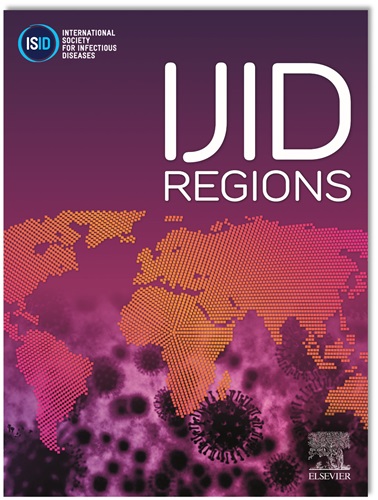抗-HBc 阳性/HBsAg 阴性 HIV 感染者转用替诺福韦稀释疗法后的乙型肝炎病毒复制动力学。
IF 4.3
2区 医学
Q1 INFECTIOUS DISEASES
引用次数: 0
摘要
目的方法:纳入101名转用TDF/TAF间隔疗法的抗HBc阳性/HBsAg阴性艾滋病病毒感染者(PWH)。通过液滴-数字 PCR 对切换时(T0)、切换后 12 个月内(T1)和切换后 12-24 个月内(T2)的血清 HBV-DNA 和 HBV-RNA 进行定量分析:T0时,33.7%的患者有隐性HBV-DNA(商业检测方法检测不到,中位数[IQR]:2[1-5]IU/ml),22%的患者仅有HBV-RNA阳性(中位数[IQR]:4[3-4]IU/ml),这表明尽管HBsAg阴性且TDF/TAF加压,但仍有活跃的HBV储库。值得注意的是,抗 HBs-titer10IU/ml从T1时的12.9%增至T2时的42.6%(P100IU/ml(P=0.02);HBV-DNA中位数(IQR):579(425-770)IU/ml)。值得注意的是,70%的隐性 HBV-DNA PWH、38.5%的仅有 HBV-RNA 的 PWH 和 25% 在 T0 时两种 HBV 标志物均为阴性的 PWH 在 T2 时 HBV-DNA>10IU/ml (P=0.01)。T0时的隐性HBV-DNA和较低的CD4+T细胞计数可独立预测T2时的HBV-DNA>10IU/ml(OR[95%CI]:8.2[1.7-40.6],P=0.01;OR[95%CI]:8.1[1.3-52.1],P=0.03)。最后,HBV-DNA 持续阳性与 T2 期 CD4+T 细胞恢复率降低独立相关(OR[95%CI]:0.07[0.01-0.77],P=0.03):本研究强调了定期监测接受 TDF/TAF 挽救方案的抗 HBc 阳性/HBsAg 阴性 PWH 的重要性,以及高灵敏度 HBV 标志物在优化其管理中的作用。本文章由计算机程序翻译,如有差异,请以英文原文为准。
Kinetics of hepatitis B virus replication in anti-HBc positive/HBsAg-negative people with HIV switching to tenofovir sparing therapy
Objectives
To unravel the still unexplored HBV-replicative kinetics in anti-HBc-positive/HBsAg-negative people-with-HIV (PWH) suspending tenofovir disoproxil-fumarate/tenofovir-alafenamide (TDF/TAF).
Methods
A total of 101 anti-HBc-positive/HBsAg-negative PWH switching to TDF/TAF-sparing therapy were included. Serum HBV-DNA and HBV-RNA were quantified by droplet-digital-PCR at switching (T0), within 12 months (T1) and 12-24 months postswitch (T2).
Results
At T0, 33.7% had cryptic HBV-DNA (undetected by commercial assays, median [interquartile range (IQR)]: 2 [1-5] IU/mL) and 22% were positive to HBV-RNA alone (median [IQR]: 4 [3-4] IU/mL), indicating an active HBV-reservoir despite HBsAg-negativity and TDF/TAF-pressure. Notably, anti-HBs-titer <100 mIU/mL independently correlated with cryptic HBV-DNA at T0 (OR [95% CI]: 2.6 [1.02-6.5], P = 0.04). After TDF/TAF-withdrawal, the rate of PWH achieving HBV-DNA >10 IU/mL increased from 12.9% at T1 to 42.6% at T2 (P < 0.0001). Likewise, a rise from 2 to 11% was observed for HBV-DNA >100 IU/mL (P = 0.02); median (IQR) HBV-DNA: 579 (425-770) IU/mL. Notably, HBV-DNA >10 IU/mL at T2 occurred in 70% of PWH with cryptic HBV-DNA, in 38.5% with HBV-RNA alone and in 25% negative to both HBV-markers at T0 (P = 0.01). Cryptic HBV-DNA at T0 and lower nadir CD4+ T-cell-count independently predicted HBV-DNA >10 IU/mL at T2 (OR [95% CI]: 8.2 [1.7-40.6], P = 0.01; OR [95% CI]: 8.1 [1.3-52.1], P = 0.03). Lastly, persistent HBV-DNA positivity was independently associated with a reduced CD4+ T-cell recovery at T2 (OR [95% CI]: 0.07 [0.01-0.77], P = 0.03).
Conclusion
This study underlines the importance to regularly monitor anti-HBc-positive/HBsAg-negative PWH undergoing TDF/TAF-sparing regimen and the role of highly-sensitive HBV markers in optimizing their management.
求助全文
通过发布文献求助,成功后即可免费获取论文全文。
去求助
来源期刊
CiteScore
18.90
自引率
2.40%
发文量
1020
审稿时长
30 days
期刊介绍:
International Journal of Infectious Diseases (IJID)
Publisher: International Society for Infectious Diseases
Publication Frequency: Monthly
Type: Peer-reviewed, Open Access
Scope:
Publishes original clinical and laboratory-based research.
Reports clinical trials, reviews, and some case reports.
Focuses on epidemiology, clinical diagnosis, treatment, and control of infectious diseases.
Emphasizes diseases common in under-resourced countries.

 求助内容:
求助内容: 应助结果提醒方式:
应助结果提醒方式:


